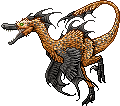


General
The tsaanguiri are adaptable creatures partial to arid habitats, and can be found in habitats ranging from volcanic deserts to open woodlands. Tsaanguiri belong a very old group of animals whose fossils date back to a time when the continents were fused into a single land mass. They are thought to share a common ancestor with birds and dragons, and tsaanguiri boast many features found in both groups. Their own wings, though vestigial and useless for flight, can be used in intricate courtship displays, where the males raise and lower their flowing frills while waving their wings to impress females. The features for which tsaanguiri are best-known - their sickle-shaped rear claws and their ability to phase through any material - are used for hunting. These intelligent creatures often work in teams to chase larger animals, drawing them into an area with overhanging rocks or trees, which other tsaanguiri will phase through to drop onto the unsuspecting animal. They then dig their claws into the prey and use their weight to pin it down, sometimes with all of the pack members piling on to help. The social structure of the tsaanguiri is not fully understood, but they seem to have good memories and keep in contact with their own pack members as well as other packs through sharp, piercing cries.
Egg
This small egg tends to sink through the top of your sock drawer if you leave it there for too long.
Hatchling
Newly-hatched tsaanguiri are no larger than ducklings, though they are far more devious. Their natural instinct is to flock with other hatchlings, a useful defense in the deserts and woodlands where they normally live. In the Keep, packs of dozens of small tsaanguiri may be seen wandering the halls, and occasionally interrupt classes when they choose to materialize through the doors or walls. Despite valiant efforts by instructors, no known substance or spell can stop the march of a determined group of fluffy tsaanguiri, though offerings of crickets and other insects may coax them off in another direction. At this size, they are not yet able to catch anything larger than an unfortunate earthworm, so the hatchlings rely on adult tsaanguiri or students to feed them. Even at a young age, the dexterity and balance of these creatures is well-developed, and they can be easily trained to perch on one's shoulder or climb into a pocket. The hatchlings learn quickly, and grow easily bored, so keeping them entertained is a constant task for any magi trying to care for one.
Adult
As a tsaanguir ages, it becomes more selective in how it phases through objects, using its ability to climb and jump after other creatures and unfortunate magi throughout the Keep. The tsaanguiri are kept under the watchful eyes of their magi, and most are trained well enough to be more of an irritation than a real danger. Wild tsaanguiri are a different matter; though lo larger than an amagnae when fully-grown, they hunt in groups and use an arsenal of sharp teeth and infamous curved claws to bring down their prey. Of interest to most magi, however, is their ability to pass through walls, apparently unhindered by the materials present. Even the valaska minerals which halt the powers of cehual boars only seem to slow tsaanguiri, perhaps because of their smaller size or because they use a different sort of magic. Whatever the case, this power does have limitations. Tsaanguiri cannot spend much time embedded in any solid surface, for if they lose their concentration, the results can be disastrous. They are also unable to carry anything with them when they phase, and their willingness to go through a particular object can vary greatly. Once seen as useful for spying on enemies, many unlucky wizards have proven that though a tsaanguir can get into a fortified castle, it is unlikely to do something useful once inside.
Notes
Obtained from: Event, Halloween, Retired
Breeding: Yes
Renaming cost: 200 gold
Release date: October 24th 2015
Element: Neutral 
Breeds with the following:
Tsaanguir + Tsaanguir = Tsaanguir (Normal)
Sprite art: Lazuli | Description: PKGriffin